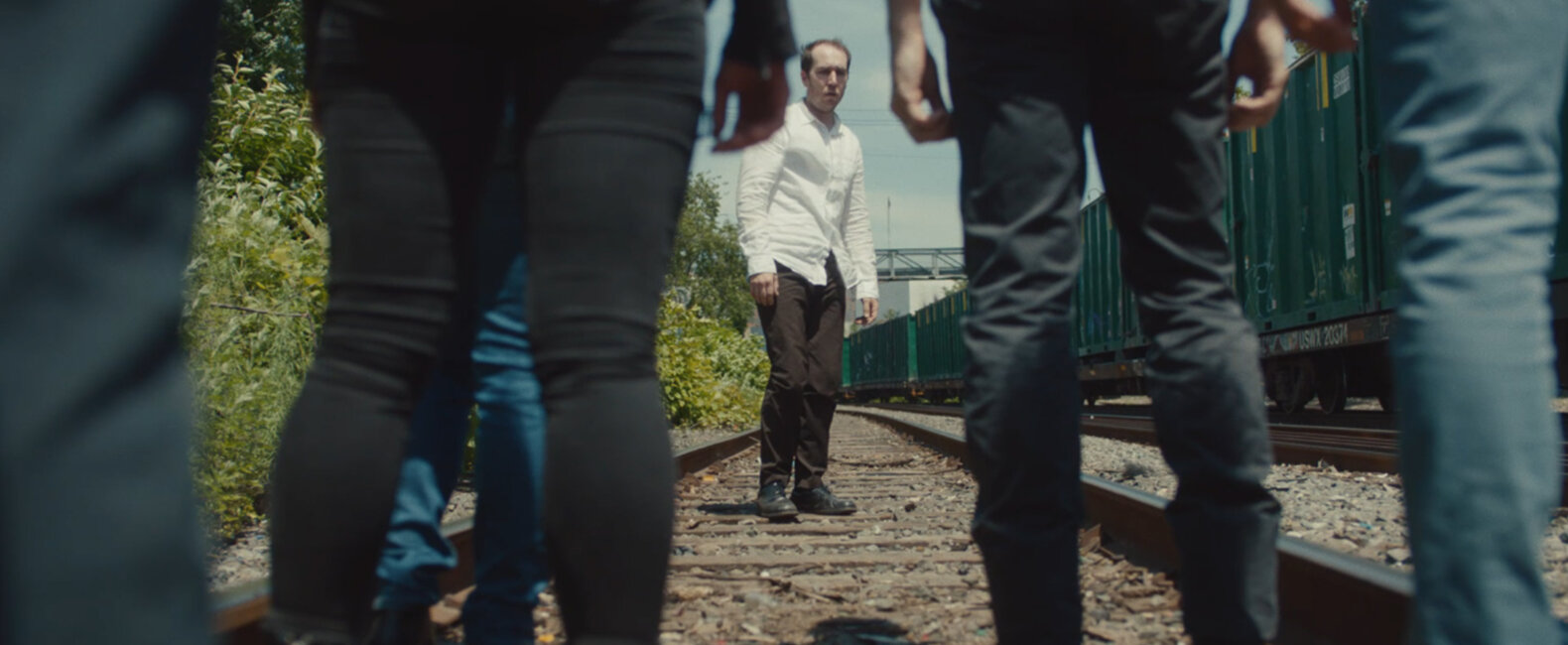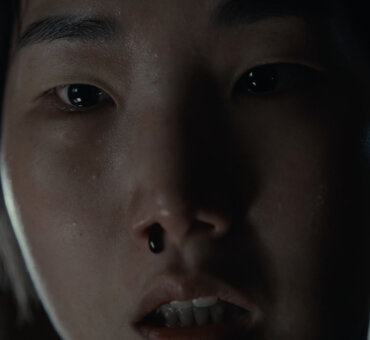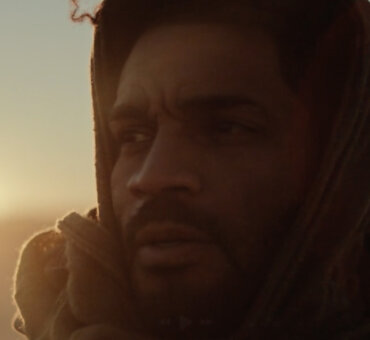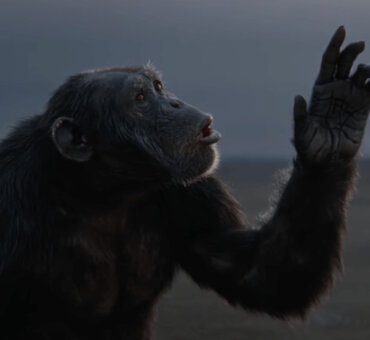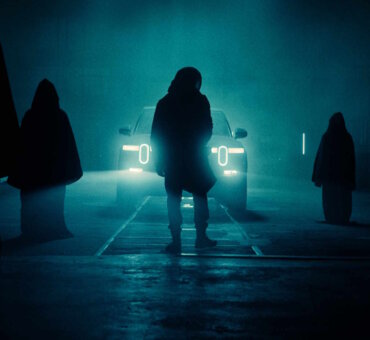Some things are exactly as hard as they look. Some things are even harder. File Radiohead’s new music video, Man of War, under the latter. Directed by Colin Read, the film is a shot-for-shot remake of… itself. It cuts back and forth between night and day, as a man tries to outrun a growing gang of lurkers. “There were no tricks or shortcuts to this,” Colin told us. “It was just very careful choreography and attention to detail.” The process was so labor intensive, in fact, that it put Colin in the hospital. “I guess I succumbed to heat exhaustion,” he said. But the result was well worth it: a music video so arresting and compelling… we’re sure you’ll watch it twice. Check out the film below and then read how Colin made it happen.
How did this Man of War project come together?
It was a very fast process. I basically had to send them a treatment in one day. And from that day until the premiere of the video was about a month. I discovered that’s not uncommon, and it’s even a bit longer than some music videos’ time frames. It was a mad scramble to put everything together.
What was your pitch? How did you boil down this concept?
Actually, the treatment was very precise. It was extremely specific, down to time stamps of where the switches would fall — the exact beats of the song — and what would be happening on each switch. It was the only way I could get my idea across. Of course I wrote a brief synopsis up front, a pitch that summed up the idea. But the accompanying script was extremely specific. And most of it ended up being used in the final shooting script. The only changes from the initial script were because of location realities and stuff like that.
What was production like?
Well, the budget was pretty low. Part of what helped us pull it off was that Todd Martin, our wonderful DP, does his own Steadicam work. So shooting was a mix of mostly Steadicam with some Easyrig and handheld. Jess Lowe, our producer, also did an amazing job pulling everything together.
I brought in Connor Kammerer as my co-director because we’d worked together on developing similar day-night segments on a few other projects, and he had made his own short day-night switching video with skateboarding as well. The overall technique is fairly simple, but it definitely requires a practice-makes-perfect approach.
Finding locations was really difficult because they had to be specific as to what the script demanded. I searched daily myself for about two weeks. I had to find the physical space that my script would fit into—which was tricky because it had very precise landmarks that would occur with very precise timing. There had to be a bench just so many paces from a turn in a sidewalk, there had to be a street to cross here, a long stretch with no streetside parking here, et cetera. Once we had locations, I revised the script a bit to fit more exactly with the actual spaces.
Then, Connor and I blocked out everything together — timing the action to the song, figuring out where each person needed to be for each beat. We then returned with limited cast members and did a more thorough blocking out. Each strike on the ground corresponded to a switch in the song from day to night, or night to day. We then choreographed down to foot placement at each strike, body language. I hired dancers to be the followers, since dancers have the most experience hitting precise blocking, over and over. Our choreographer, Katherine Fisher, helped the dancers learn the timing and the repetition of body language and motion.
Then I made an audio track of the “Man of War” song that had audio cues for each switch. Actually, I made two audio tracks: one had beeps to cue each transition; the other had my frantic narration layered over the entire song. That was a study guide for the actors, telling them exactly where they needed to be and exactly what they needed to be doing. It was probably terrifying to listen to, but we had to nail it down through repetition — everybody hitting their marks at the right time every time. There were no tricks or shortcuts to this. It was just very careful choreography and attention to detail.
So you did a day shoot and then came back and shot the exact same thing at night?
Yes, except the opposite. We shot the night stuff first on a Friday night from 5:00 p.m. to 5:00 a.m. The actual shoot started around 10:00 p.m. when it was fully dark. Then we returned at 5:00 a.m. on Sunday morning and shot for 12 hours.
On Saturday, in between the shoots, I took the night footage and made an edit with black spaces where the day footage would be inserted. That way I had video to show all the actors, so they could see what movements they were doing at the beginning and ending of each clip. That helped to create a match. I also pulled still frames of each switch. I had those on an iPad, so we could look at the exact framing and replicate that during the day shoot.
Did you shoot the day footage continuously then, or just fill in the gaps?
On both days, it was a mix. Whenever possible, we’d shoot as many continuous sections as we could. But to get the exact matched frames — or as close as we could get to exact — we had to shoot it in chunks.
It sounds pretty exhausting.
Oh, it was. I ended up in the hospital after the day shoot. I’d been running on almost no sleep for quite some time, working on this video 24/7, shooting in 96-degree heat. I just didn’t think about drinking water, and I guess I succumbed to heat exhaustion. I started throwing up everything in my system, and I had to go to the hospital to get an IV to put fluids back in me.
Wow. How long did it take to put the video together once you had all the footage?
Well, by necessity, it was very quick. I think I had three days after shooting to get to picture lock. The time line was crazy. The good part of the process was that we were almost doing an in-camera edit. It’s not like there was a ton of leeway in the shot choices, since everything was so carefully choreographed. We shot exactly what we needed, exactly for the script. So in a way, there wasn’t a lot of second-guessing structurally. The tricky part was choosing between takes. I had to put it all together like a puzzle, find the best take for each section, and hope it would match up with the best take of the next section. But sometimes it didn’t work exactly as planned. A shot would end up running a little bit longer or a little bit shorter—and I’m talking long or short by a matter of several frames, but in this edit, a difference of a frame or two could make or break a clip. So I had to sometimes not use an “ideal take,” because what might not be the best take in a vacuum, would be the best fit with the clips to the left and right of it.
The final assembly ended up being done in After Effects. We’d shot wide in 4K with this in mind, so I could punch in and line up the frames more closely.
Did everything come together as expected?
Todd did an incredible job matching up the framing in-camera. But it is a wide frame. There’s so much going on. It was impossible to get all the borders exact. Then when I got to the later parts of the video, I had to get creative with the timing because the day-night shifts during the chase scene didn’t necessarily hit on the beats I’d initially planned; I’d had to improvise on-location a bit due to location quirks that arose unexpectedly. But it all worked out in the end.
Did you work closely with Radiohead?
They were on tour. So other than their initial comments — which were passed on via email ⎯ their requests for changes that we couldn’t do, and their eventual approvals, not really. That was the extent of our communication. But everyone involved was really gracious and open to our process, which was a breath of fresh air. They trusted me and my vision.
Do you have a particular approach to generating ideas or coming up with concepts?
That’s like asking, “How does a brain work?” which is kind of hard to answer. The type of concepts I usually get excited about are ones I can achieve through practical methods, but that are innovative in the way I can make them happen. And, more importantly, they’re concepts that are fun to make. I mean, there were a lot of things about the Man of Warvideo that were not fun. Hospital stay included. But the actual concept and the way things lined up — just watching the magic happen while we put it together — was really exciting. It was fun. I’m constantly chasing that feeling — the sense that I am doing something technically innovative that is still fun to make. That’s probably why I’m a filmmaker. You can tell when someone puts love into their work.
—
All photos courtesy of Katherine Helen Fisher with Safety Third Productions
—
For more on editing and directing, check out these related articles:
How Bennett Johnson Made a Documentary Music Video in the Middle of a Protest
